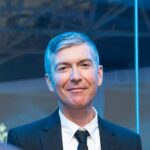Modern land surveying has witnessed remarkable advancements, particularly the way measurements are taken and how data is collected in the field. Among these advancements are the Robotic Total Stations (RTS). These high-tech instruments combine precision with automation to streamline the surveying process, making it faster and more accurate.

“Robotic Total Stations (RTS) combine traditional surveying precision with automation, significantly enhancing accuracy, efficiency, and safety in fieldwork,” says David Manzano Sales and Technical Support – East Africa OPTRON (Pty) Ltd.
He further elaborates that, “These advanced tools utilize precision motors and intelligent tracking systems, enabling remote control of movement, target alignment, and data collection, which reduces human error and fatigue. RTS also communicate with surveying software for real-time data updates, streamlining decision-making.”

Sharing his opinion, Andrea Bianchi – COO at Stonex adds that, “Robotic total stations bring significant advantages to surveying and construction, enhancing productivity, accuracy, and efficiency.”
Advantages of Using Robotic Total Stations
Robotic Total Stations offer substantial benefits that can revolutionize your surveying processes. Here is how these innovative systems are transforming the Land Surveying field:
Increased Productivity and Reduced Field Time
RTS systems drastically reduce the time required for fieldwork. With the ability to automate measurements and operate remotely, they eliminate the need for crews and long hours.

Speaking with Eric Nyadimo, ISK President and the Managing Director – Oakar Services Ltd, he affirms that, “Features like auto-levelling and automated orientation reduces set up time. Automated measurements and data logging also speed up the surveying process.” He adds, “Single person operation has the advantage of both reduced labor costs and increased productivity. Since a Robotic Total Station can track and lock onto the prism automatically, interruptions caused by manual adjustments are minimized.”
Emphasizing on the time saving advantage, Bianchi stresses that, “These instruments allow a single person to operate the system, eliminating the need for a second surveyor. They automatically track and lock the target prism, enabling remote control through a field controller.”
Improved Accuracy in Measurements
Precision is critical in land surveying, RTS systems deliver unparalleled accuracy. According to Nyadimo, “Automation and real-time communication between instrument and operator reduces human errors during data collection. Robotic Total Stations also provide high precision in angle and distance measurements.”
“RTS offer exceptional accuracy in measuring angles and distances, minimizing errors,” comments Manzano.
In his remarks, Bianchi asserts, “RTS provides high accuracy angles and distance readings, ensuring reliable results for several tasks like construction staking, topographic surveys, and as-built documentation. Their advanced tracking systems minimize human errors.”
Improved Efficiency in Challenging Environments
Working in difficult terrains, such as dense forests, steep slopes or uneven ground, can be physically demanding and time-consuming using traditional methods. Robotic total stations, significantly ease these challenges.
As Nyadimo perceives, “Robotic Total Stations can handle large scale projects with long range measurements.” He further states that, “Most Robotic Total Stations are designed to withstand various environmental conditions, ensuring consistent performance.”
“Ideal for dynamic and complex environments, robotic total stations handle a variety of applications, from small construction layouts to large infrastructure projects, while maintaining efficiency in challenging conditions,” heightens Bianchi.
Enhanced Safety for Surveyors
Surveying in hazardous environments often poses risks. RTS systems allow surveyors to maintain a safe distance from dangerous areas, as the equipment can be controlled remotely. This ensures efficient operations without compromising safety.
“The Remote Operation feature enables Land Surveyors to position themselves optimally and avoid hazardous areas ensuring safety of the surveyor. Reduced on site movement and equipment handling also ensure safety for both the surveyor and equipment. Data can also be transmitted wirelessly to a central system enabling immediate verification and processing,” adds Nyadimo.
“Remote control capabilities reduce the need for surveyors to traverse hazardous terrains, improving safety,” enhances Manzano.
Cost Savings in Projects
By requiring fewer personnel and optimizing fieldwork, RTS systems significantly cut costs. The time saved translates into reduced labor and operational expenses, providing a high return on investment for surveying firms and professionals.
“A single surveyor can control the device remotely, reducing the need for multiple personnel and speeding up the surveying process,” says Manzano.
Additionally, “By automating tasks and reducing labor requirements, robotic total stations speed up workflows, lower operational costs, and improve resource allocation,” highlights Bianchi.
Streamlined Data Collection and Processing
Robotic total stations are often integrated with sophisticated software packages that allow seamless data collection, processing, and analysis. This integration streamlines workflows and minimizes the potential for errors during data transfer and processing. The digital data collected can be easily exported to various software applications for further analysis and integration with other project data.
“Robotic total stations integrate seamlessly with GNSS systems and field software, allowing real-time data transfer thanks to Android functionalities. This feature enhances on-site decision-making and workflow continuity,” says Bianchi.
Commenting on data collection and processing, Nyadimo adds, “Robotic Total Stations can also be integrated with GIS, CAD and other software for post-processing and data analysis.”
“RTS integrate with design software for real-time project updates, ensuring effective coordination,” enhances Manzano.
Applications of Robotic Total Stations in Land Surveying
RTS technology is versatile, making it suitable for a wide range of surveying tasks. Conferring to Manzano, “Applications range from construction site layouts and land surveying to monitoring structural deformation.” He further adds that, “When choosing an RTS, consider factors like accuracy, ease of use, battery life, data compatibility, and durability to ensure optimal performance in field conditions.”
Topographic and Boundary Surveys
Robotic Total Stations are ideal for creating detailed topographic maps and determining precise property boundaries. Their accuracy ensures compliance with legal requirements.
“Robotic Total Stations can handle various tasks including topographic surveys, construction layouts and as built documentation,” Says Nyadimo.
Construction Layout and Monitoring
In construction, RTS systems play a pivotal role. They facilitate the accurate placement of structures, enabling engineers to adhere to design specifications. Additionally, they monitor changes during construction for quality control.
Geospatial Mapping and Disaster Management
Large-scale mapping projects benefit significantly from RTS technology. In disaster-prone areas, they help assess risks and plan for resilience.
Unlock Your Workflow
Robotic Total Stations are transforming the field of land surveying. They not only improve accuracy and safety but also enhance productivity and reduce costs. “Embracing RTS technology can transform surveying by improving precision, efficiency, and safety across various industries,” concludes Manzano.
Whether you’re conducting topographic surveys or ensuring precise construction layouts, RTS systems are essential tools for modern surveyors. As technological advancements continue, their role in surveying will only grow stronger. Consider integrating Robotic Total Stations into your workflow to unlock these advantages in your upcoming projects.



